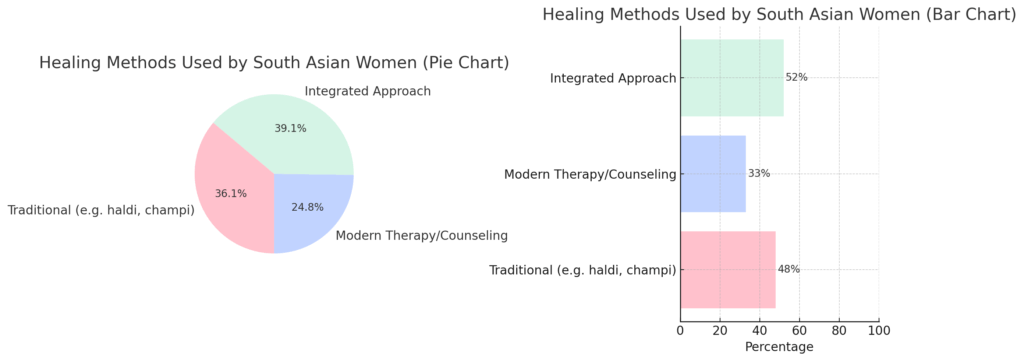
We grew up with turmeric milk for a cold, oil massages for a headache, and prayers whispered over our foreheads when our hearts were heavy. Our nani’s nuskhe (grandmother’s remedies) weren’t just folk traditions — they were survival, healing, and comfort passed through generations. But how do we reconcile those ancestral practices with the realities of mental health in today’s world?
This is where tradition meets therapy, and where we learn that healing doesn’t have to look Western to be valid.
Reclaiming Ancestral Wisdom


Traditional South Asian remedies weren’t just physical cures. They often doubled as emotional and spiritual support:
- Haldi doodh (turmeric milk) for inflammation and emotional warmth
- Champi (oil head massage) as a grounding act of care
- Yogic breathing to regulate emotions
- Rituals like prayer, diya lighting, and storytelling that offered structure and spiritual soothing
These rituals hold space for peace in a world that often silences South Asian women’s emotions. But they aren’t replacements for therapy — they’re companions to it.
Modern Mental Health + Cultural Practice: A Combined Path
Instead of choosing between Western therapy and cultural healing, many South Asian women are integrating both:
- Using guided meditations in their native language
- Seeking therapists who understand their culture
- Creating mental health check-ins during tea time with loved ones
- Adapting ancestral rituals with intention — not obligation
Healing doesn’t have to be either/or. It can be both/and.
Stats: The Shift Toward Integrated Healing

- 52% of South Asian women said they use both traditional remedies and modern mental health tools
- 67% said cultural familiarity in a healing practice makes them feel more emotionally safe
- Only 14% said they rely solely on one or the other
(Source: SAWHI Community Poll, 2023)
Real Voices
“My nani used to put her hand on my head and just sit with me in silence when I was sad. Now I realize — that was her version of therapy.”
— Nadia, 29, U.S.
“I journal in Tamil and light a diya every morning before work. It doesn’t replace therapy — it grounds me for it.”
— Meera, 35, India
📊 Infographic Summary
Bar Graph: Healing Methods Used by South Asian Women
| Healing Practice | % of Women Using It |
|---|---|
| Traditional (e.g. haldi, champi) | 48% |
| Modern Therapy/Counseling | 33% |
| Integrated Approach | 52% |
Pie Chart: Preference for Culturally Familiar Healing
- Prefer culturally familiar methods: 67%
- Neutral: 19%
- Prefer Western-only methods: 14%
✅ Worksheet Prompt: What Healing Looks Like for You
| Reflection Prompt | Your Response |
|---|---|
| A traditional remedy or ritual that comforts me: | __________________________ |
| A modern mental health practice that supports me: | __________________________ |
| How I feel combining both practices: | __________________________ |
| One thing I want to explore more: | __________________________ |
Quote to Carry With You:
“Healing isn’t new to us. Our ancestors taught us how — we’re just giving it new language.”
No Responses